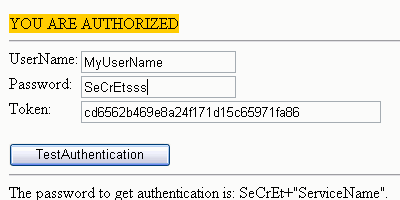本文转自:http://www.codeproject.com/Articles/9348/Web-Service-Authentication

Introduction
This is a simple mechanism to authenticate users to a Web Service, using a Time Token and MD5 Hashing to encrypt password.
Background
In CodeProject, you can find at least two others' mechanism to authenticate users to a Web Service. Dan_P wroteAuthentication for Web Services as a Simple authentication for web services using SOAP headers. But the username and password are sent in clear text and there is no encryption for the data. HENDRIK R. is the author of An introduction to Web Service Security using WSE, that is really a complete solution, but too much complicated for my purposes. The username is sent in clear text, but it is possible to use Password Digest to encrypt the password. The data are encrypted using XML Encryption specification to encrypt portions of the SOAP messages.
My solution is something in the middle of the above two. The username is sent in clear text, but I use MD5 to encrypt the password. I do not need to send sensitive data, so the data returned by the Web Service is not encrypted.
Using the Code
The basic idea is to send UserName and Password from the client to the Web Service using MD5 Hash Code as encryption system. In this way, the password never travels in clear over the network. The Web Service retrieves the user password from a DB or anything else and uses the same MD5 algorithm to test if the password is correct. To be sure that if someone intercepts the Hash, this can be used to authenticate in a later time, I added a timestamp before hashing the Key string. Last, as we are not always on the same server and/or the client clock may be in a different Time Zone or simply not synchronized, I added the possibility to request a Token containing the time mark to the server.
I provided a sample in ASP.NET C# for the client side, but it is possible to use any language: ASP classical JScript or VBScript, PHP, Python, etc. Anyway, on the client side we need to build up the Key using UserName, Password and the hashed timestamp Token previously got from the same Web Service. We can then call the Service and we will get the answer (or an authentication failure warning) that is displayed on the web page.
private void ButtonUseToken_Click(object sender, System.EventArgs e) { string ret; string UserName, Password, ServiceName, Token; string Key, ToHash; UserName=this.TextBoxUserName.Text; Password=this.TextBoxPwd.Text; ServiceName=this.TextBoxService.Text; Token=this.TextBoxToken.Text; ToHash=UserName.ToUpper()+"|"+Password+"|"+Token; Key=Hash(ToHash)+"|"+UserName; ServicePointReference.ServicePoint Authenticate = new ServicePointReference.ServicePoint(); ret=Authenticate.UseService(Key, ServiceName); this.ServResponse.Text=ret; }
The MD5 Hash procedure is very simple in C#; this one was written by Vasudevan Deepak Kumar in Securing Web Accounts.
private string Hash(string ToHash) { // First we need to convert the string into bytes, // which means using a text encoder. Encoder enc = System.Text.Encoding.ASCII.GetEncoder(); // Create a buffer large enough to hold the string byte[] data = new byte[ToHash.Length]; enc.GetBytes(ToHash.ToCharArray(), 0, ToHash.Length, data, 0, true); // This is one implementation of the abstract class MD5. MD5 md5 = new MD5CryptoServiceProvider(); byte[] result = md5.ComputeHash(data); return BitConverter.ToString(result).Replace("-", "").ToLower(); }
On Web Service server side, I implemented just three Web Methods:
GetToken is used to get the Time-marked token. The token you get this way is intended to be used in the basicAuthenticate method, or in the UseService that can also verify the access rights for the users authenticated to the requested service. The core of the system is implemented by TestHash. Here the password is hard-coded, but in the sample provided, you have also the code to get it from a database:
private bool TestHash (string HashStr, string UserName, int minutes, string ServiceName) { string Pwd, ToHash; string sResult, sResultT, sResultToken; try { // JUST FOR TEST: the password is hard-coded: Pwd="SeCrEt"; DateTime dt = DateTime.Now; System.TimeSpan minute = new System.TimeSpan(0,0,minutes,0,0); dt = dt-minute; //before hashing we have: //USERNAME|PassWord|YYYYMMDD|HHMM ToHash=UserName.ToUpper()+"|"+Pwd+"|"+dt.ToString("yyyyMMdd")+ "|"+dt.ToString("HHmm"); sResult = Hash(ToHash); //TokenWeGotBefore ToHash=dt.ToString("yyyyMMdd")+"|"+dt.ToString("HHmm"); sResultToken = Hash(ToHash); //USERNAME|PassWord|TokenWeGotBefore ToHash=UserName.ToUpper()+"|"+Pwd+"|"+sResultToken; sResultT = Hash(ToHash); if ((sResult==HashStr) || (sResultT==HashStr)) return true; else if (minutes==0) // allowed max 2 minutes - 1 // second to call web service return TestHash (HashStr, UserName, 1, ServiceName); else return false; } catch { return false; } }
To request a hashed time-stamped Token to the Web Service, the method is:
[WebMethod] public string GetToken () { string ToHash, sResult; DateTime dt = DateTime.Now; ToHash=dt.ToString("yyyyMMdd")+"|"+dt.ToString("HHmm"); sResult = Hash(ToHash); return sResult; }
The method that checks the user authentication is also kept very simple; in a real application you normally need to access a database to check the authentication level and may need to return some data to the caller:
[WebMethod] public string UseService (string Key, string ServiceName) { string [] HashArray; string UserName, level; // Key string: HASH|User|OptionalData HashArray=Key.Split('|'); level = "-1"; //default level if (TestHash(HashArray[0], HashArray[1], 0, ServiceName)) { try { UserName=HashArray[1]; // JUST FOR TEST: the User authentication level is hard-coded // but may/should be retrieved from a DataBase switch (UserName) { case "MyUserName": level="1"; break; case "OtherUser": level="2"; break; default: level="-1"; break; } if (level=="1") return "YOU ARE AUTHORIZED"; } catch (Exception exc) { return "Authentication failure: " + exc.ToString(); } } return "Authentication failure"; }
Points of Interest
TestHash checks to see if the Hash contains a timestamp or an already-hashed token, and calls itself once again in case of failure: if someone is calling the service, let's say, at 11:34:58 the Key is valid from 11:34:00 until 11:35:59, that is during two minutes minus one second.
The client side may be implemented in any language: ASP classical, JScript or VBScript, PHP, Python, etc. I have the intention to post this code too next time...